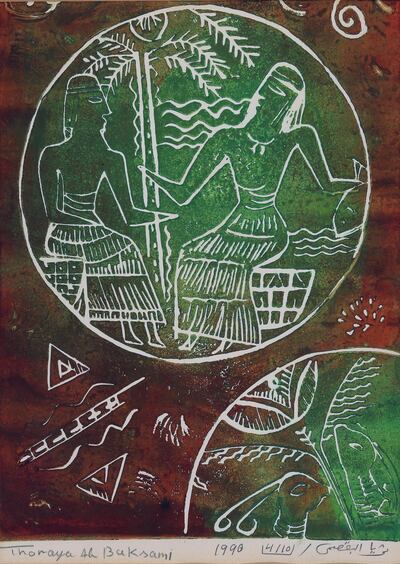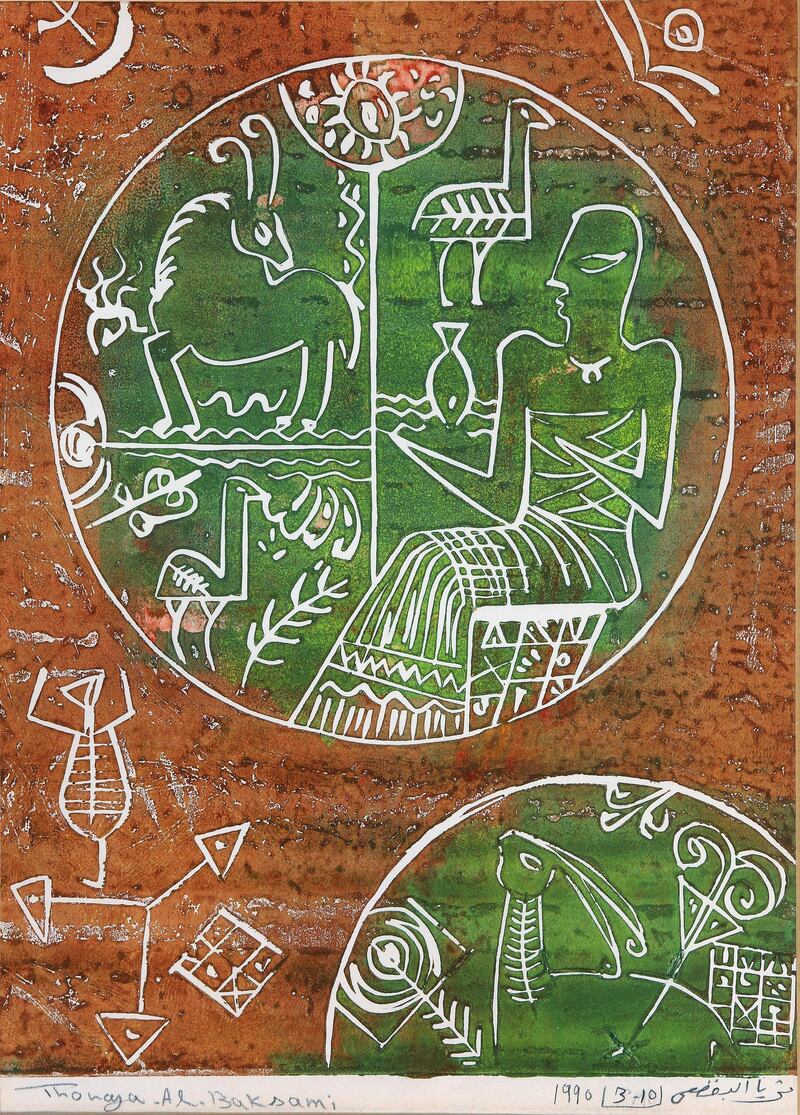These two linocuts, by Kuwaiti artist Thuraya Al Baqsami, evoke ancient mythology, showing the meld of civilisations historically in the Gulf and within the artist’s own life. They were made while she was staying on the Kuwaiti island of Failaka, about 20 kilometres off the coast of Kuwait City, and reference the Greek seals that were found on the island – Failaka was colonised by the Greeks during the reign of Alexander the Great.
These works show four circles, two of them in the centre of each print, and two of them in part. The circles encapsulate scenes between a suite of archetypically drawn figures; the one on the right is broken up almost as a crest, with different animals and a handless figure in the quadrants. Still, if these works bear influence from Greek mythology, it’s not pure Greek mythology – indeed it might be safer to say that they are just “mythic”, incorporating symbology from a number of cultures and so becoming instantaneously, though inscrutably, suggestive.
This mix of styles is typical for Al Baqsami, an artist whose life has followed a unique geographical trajectory. Like many of her era (she was born in 1951), she studied art in Cairo, but after that her path differs from the norm.

She received a master’s at the Surikov Institute in Moscow and then followed her husband, a diplomat, on his postings throughout Africa. She learnt silk painting and batik in Dakar, Senegal and her work was influenced, both in terms of medium and style, by the cultures and landscapes she encountered – baobab trees, for example, are a recurrent motif in her early 1980s works. These keep company with images of Arabian life, particularly that of women: figures in black abayas or in brightly coloured dresses, with wavy hair streaming down. As well as an artist, Al Baqsami was a poet and feminist, agitating for woment’s rights.
Al Baqsami was in Kuwait during the Iraqi invasion of 1990-1991, when her husband was taken as a prisoner of war. She entered into what can be called, with minimum exaggeration, her blue period. Her works became more formal, moving from detailed painted scenes to simply executed figures, with faces often raised towards the sky in expressions of anguish. Her palette became monochrome, in blues and blacks, and it is stunning to see how her use of colour is so closely indexed to the political events around her. Come 1993, her paintings spring back into the colours of the rainbow.
An unusually depictive painting titled The Return of the Parted shows what we can presume is some of the reason for the switch: her husband occupies the centre of the canvas, surrounded by Al Baqsami and her three daughters.
_______________________
Read more:
How Nargess Hashemi imagined a new urban utopia, one colour shade at a time
The story behind Ai Weiwei's Fountain of Light at Louvre Abu Dhabi
In the frame: Basim Magdy, The Dent, 2014
_______________________
One of these daughters has become a well-known artist in her own right: Monira Al Qadiri, and last year, Al Qadiri curated the stunning retrospective of her mother’s work at the Sharjah Art Museum as part of its Lasting Impressions series, which looks at under-studied, but important artists. (Al Qadiri will also collaborate with Abu Dhabi Art this autumn.)
Comprising more than 200 works, the show introduced the range of Al Baqsami’s idiosyncratic, celebrational, brightly imaginative paintings of life and women to those who only knew her through the odd work. These linocuts from the Failaka series were made in 1990, but do not display the full perturbation of the work made during the Gulf War. (I could not ascertain whether they were perhaps made before the August invasion.)
In 1990, Al Baqsami used the linocut medium to make a protest poster against the invasion, and Greek seals became for her a metaphor of aggression, but these works suggest an investigation of historical symbols and their relation to animal and human life, rather than a political messaging.
They are on permanent display at the Sharjah Art Museum – she donated them in the late 1990s – so you can go and try and untangle what their enigmatic meaning might be.






